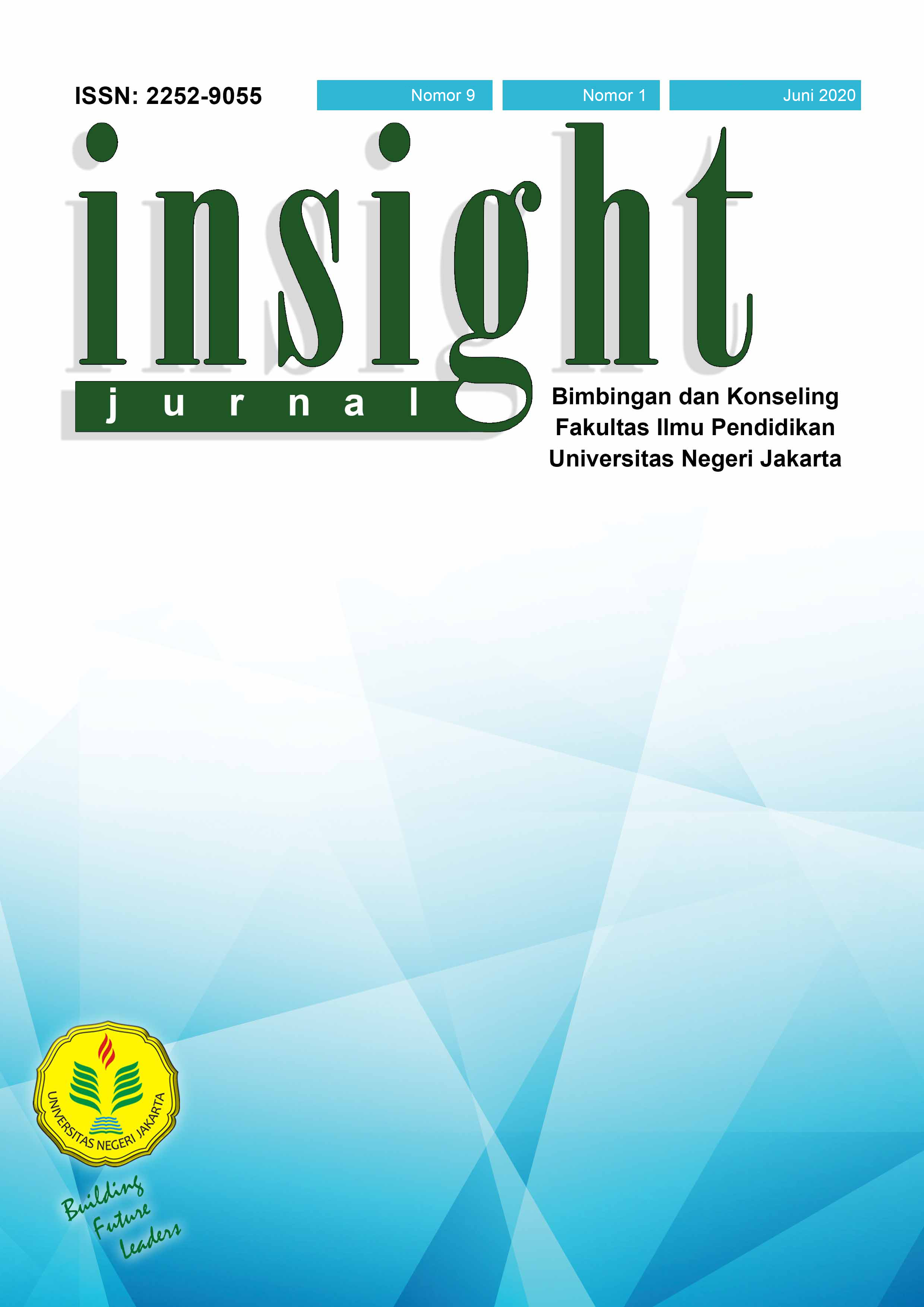Studi Kasus Kekerasan Emosional Pada Laki-Laki Muda Feminin (Feminine Youth Male)
DOI:
https://doi.org/10.21009/INSIGHT.091.08Keywords:
Laki-Laki Feminin, Stigma, Kekerasan EmosionalAbstract
Penelitian ini bertujuan untuk mengetahui dan memahami kekerasan emosional yang dialami oleh laki-laki feminin. Penelitian ini menggunakan pendekatan kualitatif dengan metode penelitian studi kasus. Metode pengumpulan data yang digunakan adalah wawancara mendalam. Analisis data yang digunakan adalah Interpretative Phenomenological Analysis (IPA). Responden pada penelitian ini terdiri dari 3 laki-laki feminin dengan karakteristik berbeda, yaitu laki-laki feminin homoseksual, laki-laki feminin heteroseksual, dan transgender. Dari penelitian ini teridentifikasi 6 tema utama yang menunjukan bentuk kekerasan emosional yang diterima oleh ketiga responden, yaitu 1) Serangan verbal dengan sub-tema cemoohan dan labelling, 2) Hubungan sosial dengan sub-tema penolakan, dijauhi, dan provokasi orang lain, 3) Kefemininan responden dengan sub-tema kesadaran kefemininan, dituntut berperilaku maskulin, serangan fisik, dan ancaman, 4) Stigma dan diskriminasi dengan sub-tema diskriminasi, dianggap homoseksual, pembunuhan karakter, dan pelecehan seksual, 5) Kehidupan religius dengan sub-tema dianggap tidak sesuai ajaran agama dan coping, serta 6) Dampak dari perlakuan yang diterima dengan sub-tema sakit hati, kesepian, tidak percaya diri, rendah diri, menyalahkan diri, self-harm, keinginan bunuh diri, dan coping.
References
Berry, J. ., Poortinga, Y. ., Segall, M. ., & Dasen, P. . (1999). Psikologi Lintas-Budaya: Riset dan Aplikasi. PT. Gramedia.
Breakwell, G. M. (2008). Introduction: Approaches to Data Collection and Data Analysis. In Doing Social Psychology Research. https://doi.org/10.1002/9780470776278.ch1
Davies, M. (2004). Correlates of negative attitudes toward gay men: Sexism, male role norms, and male sexuality. Journal of Sex Research, 41(3), 259–266. https://doi.org/10.1080/00224490409552233
Engel, B. (2002). The emotionally abusive relationship: How to stop being abused and how to stop abusing. In The emotionally abusive relationship: How to stop being abused and how to stop abusing.
Fitri, S., Luawo, M. I. R., & Tarzia, W. (2017). Sikap Guru Bimbingan Konseling SMA Negeri DKI Jakarta Terhadap LGBT (Lesbian, Gay, Biseksual Dan Transjender) Di Sekolah. Insight: Jurnal Bimbingan Konseling, 6(1), 105. https://doi.org/10.21009/insight.061.10
Fitri, S., Luawo, M. I. R., & Wulandari, R. (2017). Persepsi Calon Konselor Mengenai Kompetensi Konseling Multikultur pada Konseli dengan Orientasi Seksual Minoritas. Insight: Jurnal Bimbingan Konseling, 6(1), 115–127. https://doi.org/https://doi.org/10.21009/INSIGHT.061
Glick, P., Gangl, C., Gibb, S., Klumpner, S., & Weinberg, E. (2009). Defensive reactions to masculinity threat: More negative affect toward effeminate (but not masculine) gay men. Sex Roles, 57(1–2), 55–59. https://doi.org/10.1007/s11199-007-9195-3
Green, E. R., & Maurer, L. (2016). The Teaching Transgender Toolkit.
Hastuti, M.M.S., & Marheni, K. . (2017). Kompetensi Konseling Multikultur bagi Konselor Sekolah Suatu Kajian Teoretis. Prosiding Seminar Dan Lokakarya Nasional Revitalisasi Laboratorium Dan Jurnal Ilmiah Dalam Implementasi Kurikulum Bimbingan Dan Konseling Berbasis KKNI, mcc, 4–6.
Hidayana, I. M. (2004). Seksualitas: Teori dan Realitas. Program Gender dan Seksualitas FISIP UI.
Hunt, J. (2013). Verbal and Emotional Abuse: Victory Over Verbal and Emotional Abuse. AspirePress.
Malti-Douglas, F. (2008). Encyclopedia of sex and gender. In Choice Reviews Online (Vol. 45, Issue 09). The Gale Group. https://doi.org/10.5860/choice.45-4756
Mardina, R. (2018). Info Data: Kekerasan Terhadap Anak dan Remaja. Kementrian Kesehatan RI.
McMurray, A., & Jantz, G. L. (2013). Hope and Healing From Emotional Abuse. Spire.
Nindya, P. N., & R., M. (2012). Hubungan Kekerasan Emosional pada Anak terhadap Kecenderungan Kenakalan Remaja. Jurnal Psikologi Klinis Dan Kesehatan Mental, 1(02), 1–9.
O`Hagan, K. (2006). Identifying Emotional and Pyschologiacl Abuse : a guide for Childcare professionals.
Roberts, A. L., Rosario, M., Slopen, N., Calzo, J. P., & Austin, S. B. (2013). Childhood gender nonconformity, bullying victimization, and depressive symptoms across adolescence and early adulthood: An 11-year longitudinal study. Journal of the American Academy of Child and Adolescent Psychiatry, 52(2), 143–152. https://doi.org/10.1016/j.jaac.2012.11.006
Rokhmansyah, A. (2016). Pengantar Gender dan Feminisme. Garudhawaca.
Ruminiati. (2016). Sosio Antropologi Pendidikan: Suatu Kajian Multikultural. Gunung Samudera.
Sandfort, T. G. M., Melendez, R. M., & Diaz, R. M. (2013). Gender nonconformity, homophobia, and mental distress in Latino gay and bisexual men. Journal of Sex Research, 44(2), 181–189. https://doi.org/10.1080/00224490701263819
Santiari, I. G. A. T., & Tobing, D. H. (2016). Hubungan antara Penerimaan Kelompok Teman Sebaya dengan Konsep Diri pada Remaja Panti Asuhan di Kabupaten Badung, Bali. Jurnal Psikologi Udayana, 3(1), 1–9. https://doi.org/10.24843/jpu.2016.v03.i01.p01
Shen, L. C. (2020). The Effeminate Boy and Queer Boyhood in Contemporary Chinese Adolescent Novels. Children’s Literature in Education, 51(1), 63–81. https://doi.org/10.1007/s10583-018-9357-7
Sreenivasan, U. (1985). Effeminate Boys in a Child Psychiatric Clinic: Prevalence and Associated Factors. Journal of the American Academy of Child Psychiatry, 24(6), 689–694. https://doi.org/10.1016/S0002-7138(10)60111-2
Thatcher, A. (2011). God, Sex, and Gender: An Introduction. Wiley-Blackwell.
Yulia, R., Yusuarsono, & SM, A. E. (2016). DISKRIMINASI PADA PRIA BERGAYA FEMININ. Jurnal Professional FIS UNIVED, 3(1).
Zuger, B. (1978). Effeminate behavior present in boys from childhood: Ten additional years of follow-up. Comprehensive Psychiatry, 19(4), 363–369. https://doi.org/10.1016/0010-440X(78)90019-6
Downloads
Published
Issue
Section
License
Authors who publish with this Journal agree to the following terms:
- Author retain copyright and grant the journal right of first publication with the work simultaneously licensed under a creative commons attribution licensethat allow others to share the work within an acknowledgement of the work’s authorship and initial publication of this journal.
- Authors are able to enter into separate, additional contractual arrangementfor the non-exclusive distribution of the journal’s published version of the work (e.g. acknowledgement of its initial publication in this journal).
- Authors are permitted and encouraged to post their work online(e.g. in institutional repositories or on their websites) prior to and during the submission process, as it can lead to productive exchanges, as well as earlier and greater citation of published works.
Users/public use of this website will be licensed to CC BY







